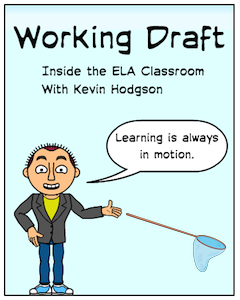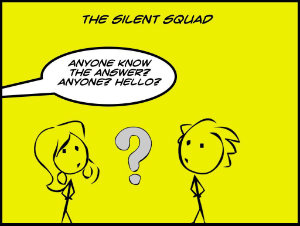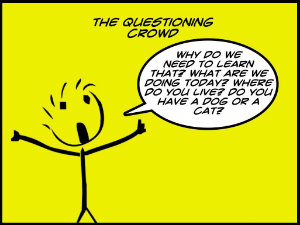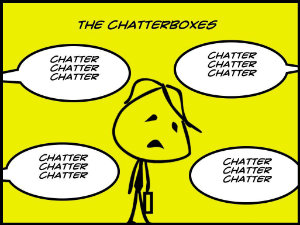A Field Study of Sixth Graders in the Wild
A MiddleWeb Blog

They’ve spent a few weeks testing the waters and are now coming into their own. You can see it in their eyes, in their behavior. The Sixth Grader is a specimen to behold.
As this comfort level is reached, something unusual and yet increasingly common happens in their habitat, here referred to as “the classroom.” The students who have been relatively randomly grouped together as a classroom (four classes, to be exact) start to form an emerging shared character personality, individuals forming the collective with a rather distinct identity all of their own.
How it is that four different collections of native creatures, known commonly as “students,” form a collective identity is a great mystery of educational and behavioral science.
The Faux Field Study
In the interests of, ahem, Science, therefore, the faux research team begins this Field Study of Sixth Graders by paying close attention to the defining characteristics of each of the four classes of sixth graders and how they differ from each other as a collective.
First, though, some common factors among the four classes under review. Each has about 20 students. The demographic cluster is mostly suburban, white, middle-class. They are mostly engaged students, with a few outliers showing boredom from time to time. The teacher is reluctant to acknowledge this, but the researcher’s neutral observations cannot be argued. Most of the adolescents have active and supportive parents, and come from stable homes.
In summary, these specimens are fairly typical sixth graders. Yet, together, the collective classes begin to establish some interesting characteristics. Here, then, is an unofficial study by this research team of each class of Sixth Graders and the characteristics that make them unique from the other three.
NOTE: These are generalities drawn from observations, told from a humorous angle in order to elicit understanding. Any call for hard data will be met with firm resistance by the researchers.
The Silent Squad

And when it is time for class discussions, and volunteers are asked to read or comment, there is often an odd solitude that settles on the room. It’s as if they are waiting for another to volunteer. During these times, one remembers the old adage: You could hear a pin drop.
The teacher finds it hard to complain about a hard-working, mostly quiet room of students. And yet … a little commotion wouldn’t hurt, either. Researchers suggest the teacher should brush up on some new jokes by studying pop culture memes and watching comedy Vine channels.
The Selfies

The Selfies are the first to find the camera and turn it on, and then, for just about every project that involves media, they turn the camera on themselves and move images of them posing into their projects. They call their friends over. Clusters huddle around a computer as the sound clicks off “three two one” and then, with the click, they move into dramatic, or humorous, poses, and invite others to repeat the process on their own computers.
The Selfies don’t think about privacy, or about permanence of the Web. They want the instant fame of a Selfie, and they want to share it with anyone and everyone. The researchers observe that The Selfies never ask the teacher to pose with them before the camera.
The Questioning Crowd

One student asks questions to push the topic further, to wonder about the world in interesting ways. Another student poses a query about a topic that was talked about 10 minutes ago and forgotten by just about everyone else in the room. Another asks questions to change the topic to a movie they saw last weekend or a book they read in second grade or a song they heard on their iPod on the bus ride into school.
They are making “connections,” as they remind the teacher, who taught them that strategy in the first days of school. They want to know about the teacher’s life outside of school. They want to know why this particular rule about walking in the hallways is in place and why that decision about recess was made, and who made it. On some days, one question from one student sparks another question from another student, and so on, until there is the observant “tsunami effect” in the classroom.
One student, when called upon, didn’t even realize their hand was up in the air. The researchers resisted the urge to guffaw. The Questioning Crowd wants to know about things, and it won’t stop until it gets some answers. The teacher often admits with a sigh that such answers are elusive and the phrase “I don’t know” becomes a common mantra from the front of the room, the researchers note. Perhaps some time on Wikipedia would help.
The Chatterboxes

The Chatterboxes are social creatures brushing up against a classroom environment that requires attention. They often forget to do homework because they are so involved in social discussions that they miss instructions from the teacher. The phrase “I didn’t know that was due today” is heard often, even as the teacher responds, “I said it about 10 times yesterday.”
The Chatterboxes are experts at furtive talking without being caught in the act. They have learned how to whisper without moving lips. How to hide behind a book and have a discussion. How to use group work time for social talk time about the weekend, or what happened on the playground during recess, or anything else other than the task at hand.
They look offended when called on to stop chattering and told to get back to work. The Chatterboxes have a lot to say on topics of their own choosing. Researchers note that the teacher often seems exacerbated by the noise levels and they suggest adopting some strategy to selectively filter the incessant talking. Earplugs, perhaps?
In Conclusion…
Of course, the research team is obliged to once again note that these generalizations of the four classes under observation in this Field Study of Sixth Graders contain many outliers — the Chatterbox who is quiet and observant; the student in the Questioning Crowd who never asks a question (see reference to “hand raised, question unknown”); The Selfie who would never in a thousand years take a picture of themselves with a computer. And the research team also notes that some days bring out different characteristics among the different groups.
It is hoped that this qualitative Field Study of Sixth Graders leads to better understanding of the 11 and 12 year old human child, situated in the typical writing classroom setting with peers, and that the teacher gets his act together and finds a way to reach every student, no matter if they pledge allegiance to The Silent Squad, The Selfies, The Questioning Crowd or The Chatterboxes.


































My third graders are sixth graders in training and I am pretty sure they will be the questioning chatterboxes- a winning combination. I enjoyed your field study. I wonder what the students would write as a teacher field study;)